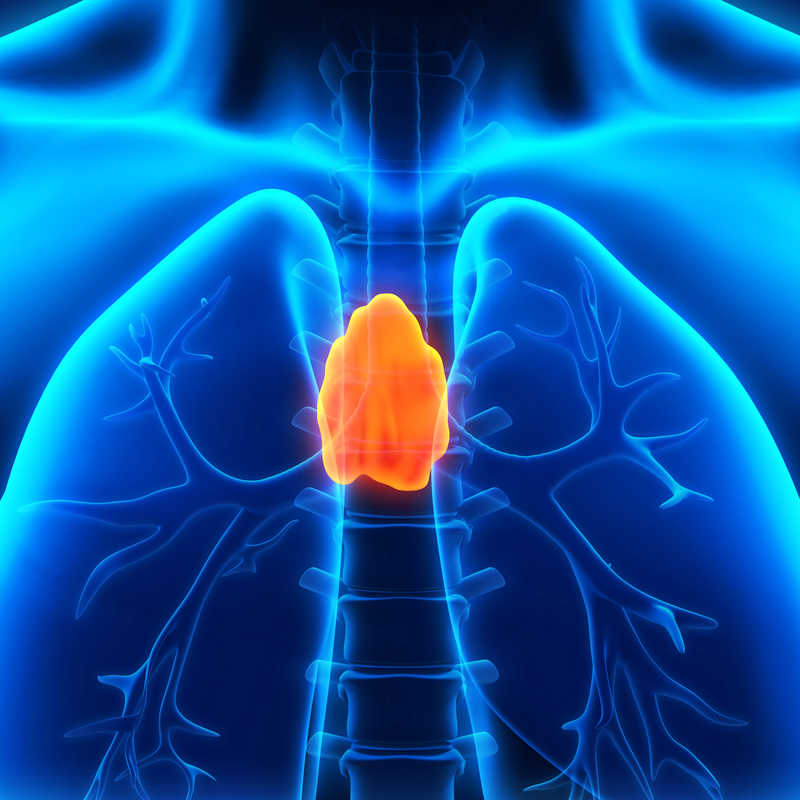
What is thymic carcinoma?
Thymic carcinoma is a cancer of the thoracic cavity, which is quite rare, with 0.2 cases per year per 100,000 inhabitants. Thymic carcinoma can occur at any age, with the average age of patients being between 30 and 60 years. Women and men are equally affected. Since the disease is rare, treatment should always be carried out in an appropriate centre, because in a special thoracic clinic, specialists and the latest therapy methods are available in a large network .
How does a thymic carcinoma develop?
The development of thymic carcinoma is associated, for example, with myasthenia gravis, polymyositis, rheumatoid arthritis, lupus erythematosus and Sjögren's syndrome. To date, however, it is not 100 % certain whether these diseases can be held responsible for the development of a tyhmus carcinoma.
What are the symptoms of thymic carcinoma?
The thymomas grow very slowly, which is why there are no symptoms for a long time. Thymic carcinoma is often discovered as an incidental finding and diagnosed. If a patient has tumour-related symptoms, these are very unspecific in most cases and are often dismissed as signs of a cold. For example, the following symptoms are described, among others:
- Pain,
- Cough,
- Hoarseness,
- Breathing problems
In addition, there are paraneoplastic syndromes. In about 45 % of patients, myasthenia gravi is also a syndrome.
How is thymic carcinoma diagnosed?
As described at , thymic carcinoma is usually discovered by chance as a mass on an X-ray ( ). The thymus is then diagnosed by CT ( ). The CT scan is then used to make the exact diagnosis. In the meantime, positron emission tomography (PET) is also being used more and more frequently for the imaging of thymic carcinoma in order to make a diagnosis. In many cases, a histological characterisation of the thymus is necessary. With their help, migrated metastases or other cancers can be excluded. However, this examination is by no means required by the professional society.
How is thymic carcinoma treated?
Once all the examination results are available, the doctors will discuss and then decide on the most efficient therapy. In the first instance this is mainly based on the spread of the thymic carcinoma. If the tumour is still limited to the thymus gland at the time of diagnosis and the patient is in good general health, surgical removal of the tumour is the goal. After surgical removal, depending on the stage of the tumour, treatment is supplemented with radiotherapy. The aim of the radiotherapy is to kill the microscopic remnants of the tumour cells, as this is essential for a reduced risk of recurrence.
If the tumour is still localised when the diagnosis is made, but it is technically impossible to operate on , an upstream therapy is sought. The aim of this therapy is to reduce the size of the tumour to such an extent that it can be removed in its entirety by surgery . Here, too, the patient receives radiation therapy after the operation.
If metastases are already present at the time of the diagnosis, chemotherapy is indispensable. Depending on the histological findings of the tumour, a targeted therapy can also be used. The so-called "targeted therapy" is a new form of treatment that is being tested in studies . The doctors in charge will always check whether a new type of therapy can be used.
What is the follow-up treatment for thymic carcinoma?
Despite an overall good prognosis for many forms of carcinoma, lifelong follow-up care will be necessary. In the follow-up care of patients, it must be kept in mind that even after a successful therapy, new manifestations of the tumour can occur in the next 10 years. Doctors must keep an eye on so-called secondary tumours such as Non Hodgkin's lymphoma and soft tissue sarcoma, which are particularly common in thymomas. In the first two years, follow-up should take place every three months with a physical examination and medical history. But a CT of the thorax should also be performed every 12 months . If there is evidence of myasthenia, it makes sense to see a neurologist at regular intervals.
What is the prognosis of thymic carcinoma?
Overall the prognosis for thymic carcinomas is excellent, but best if they were completely encapsulated and could be completely removed . In some cases, a thymic carcinoma cannot be completely removed because the tumour has already spread. An operation is nevertheless advisable, as a reduction of the tumour mass can also significantly improve the survival rate. Essential is the post-radiation, which must take place.
With thymic carcinoma, the 5-year survival rate is very high at more than 80 %. Of course, survival is strongly dependent on the growth behaviour as well as the infestation of a new thymic carcinoma. Only in about 9 % of the cases female daughter tumours occur. For this reason, local tumour removal is always a priority. Some important factors can also have a positive influence on survival. These include the removal of the tumour whole and healthy, the presence of a capsule and a low stage of the tumour.
Which doctors are the right ones to treat thymic carcinoma?
Mostly specialist doctors, oncologists and thoracic surgeons are the doctors who are the first and important choice for treatment of thymic carcinoma. Since thymic carcinomas fall into the area of interdisciplinary oncology in terms of treatment, the therapy requires close cooperation between different specialist groups and the surgeons. This also applies to the follow-up treatment of patients.
Can the development of thymic carcinoma be prevented?
As with most other types of tumours, there are no reliable methods for preventing the development of thymic carcinoma . To date, it is still completely unclear to what extent a genetic disposition exists.
